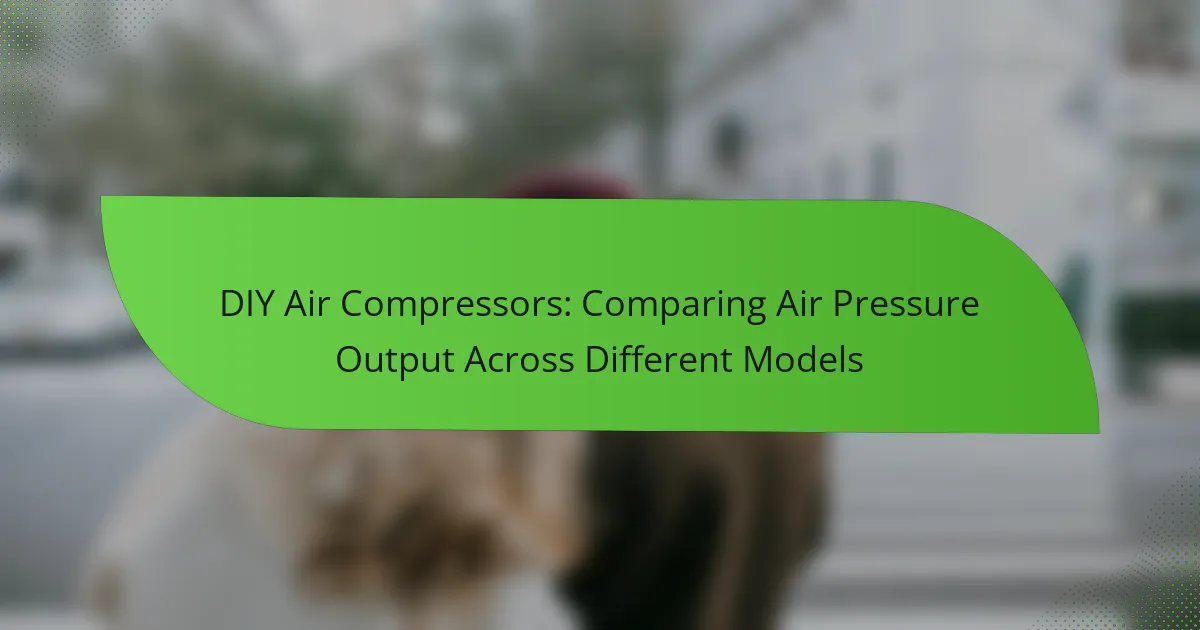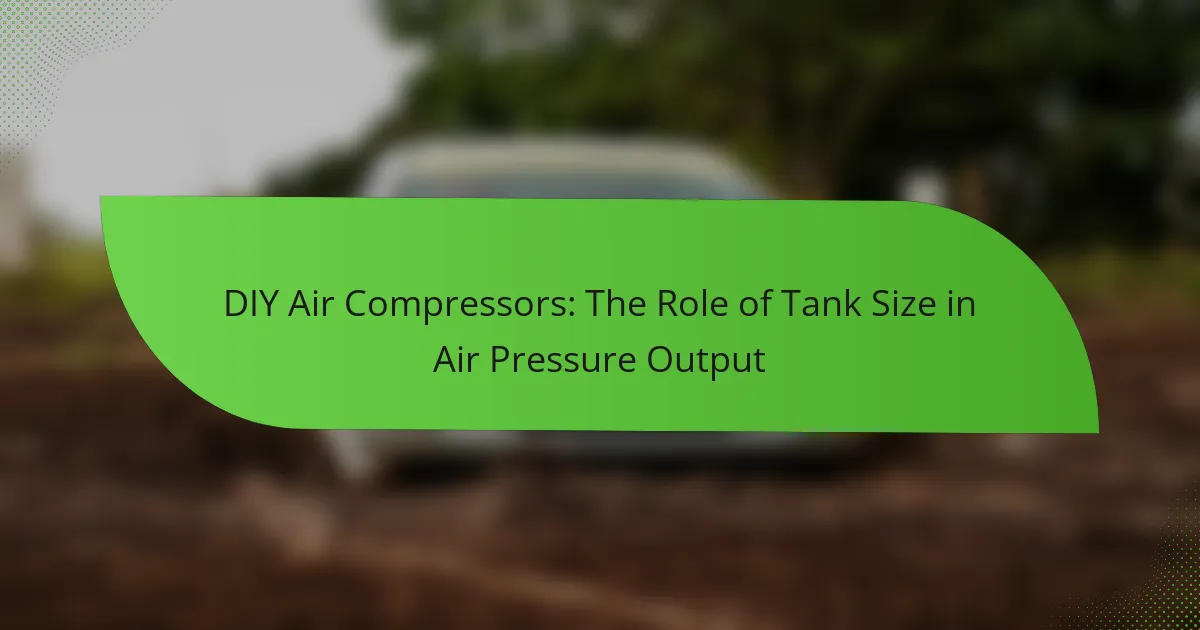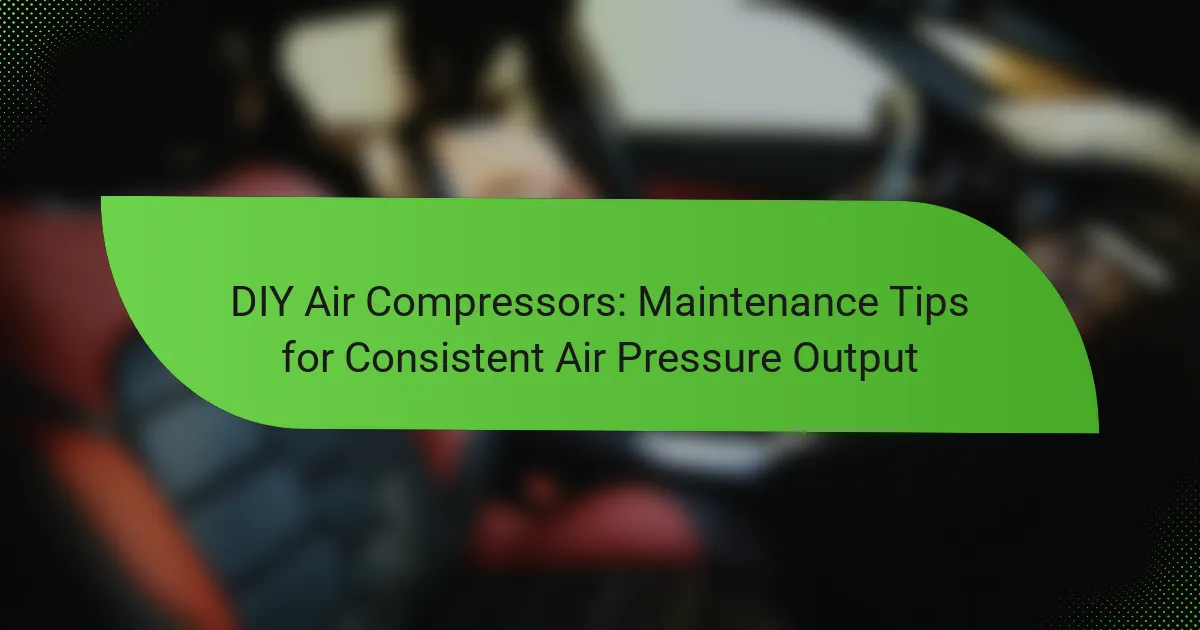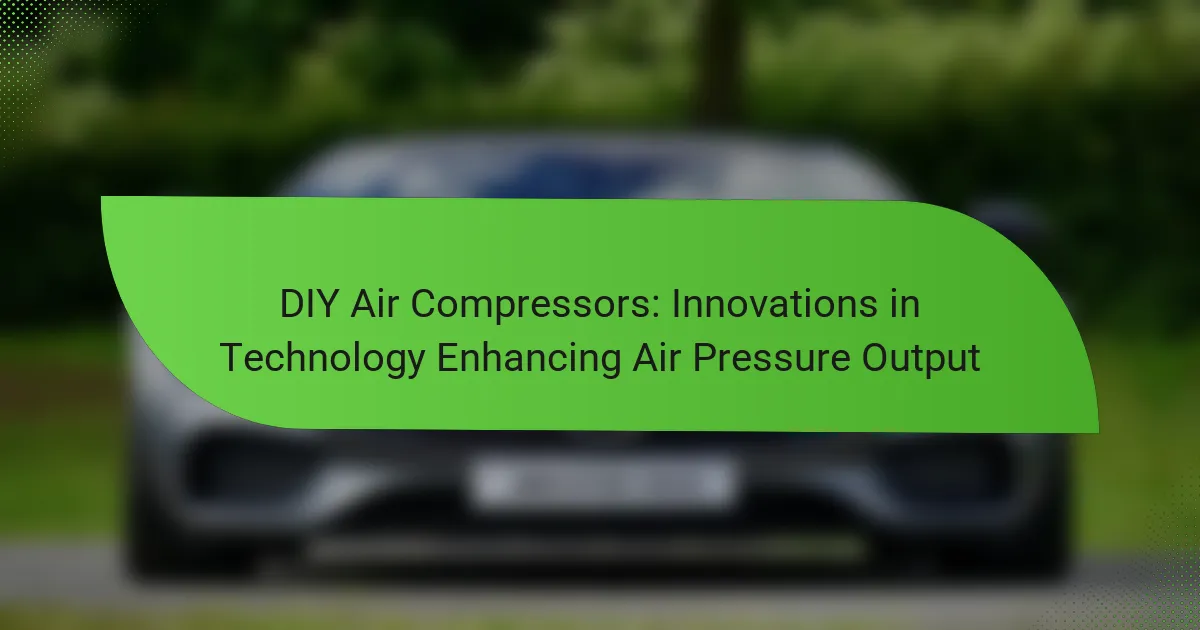DIY air compressors are devices that convert power into compressed air for various applications, including inflating tires and powering pneumatic tools. The performance of these compressors is heavily influenced by motor power, which directly affects air pressure output measured in pounds per square inch (psi). Selecting the appropriate motor, based on horsepower and efficiency, is crucial for achieving desired air pressure levels. Additionally, understanding the duty cycle and airflow requirements in cubic feet per minute (CFM) is essential for optimal performance. This article provides insights into how motor power impacts the functionality and efficiency of DIY air compressors.
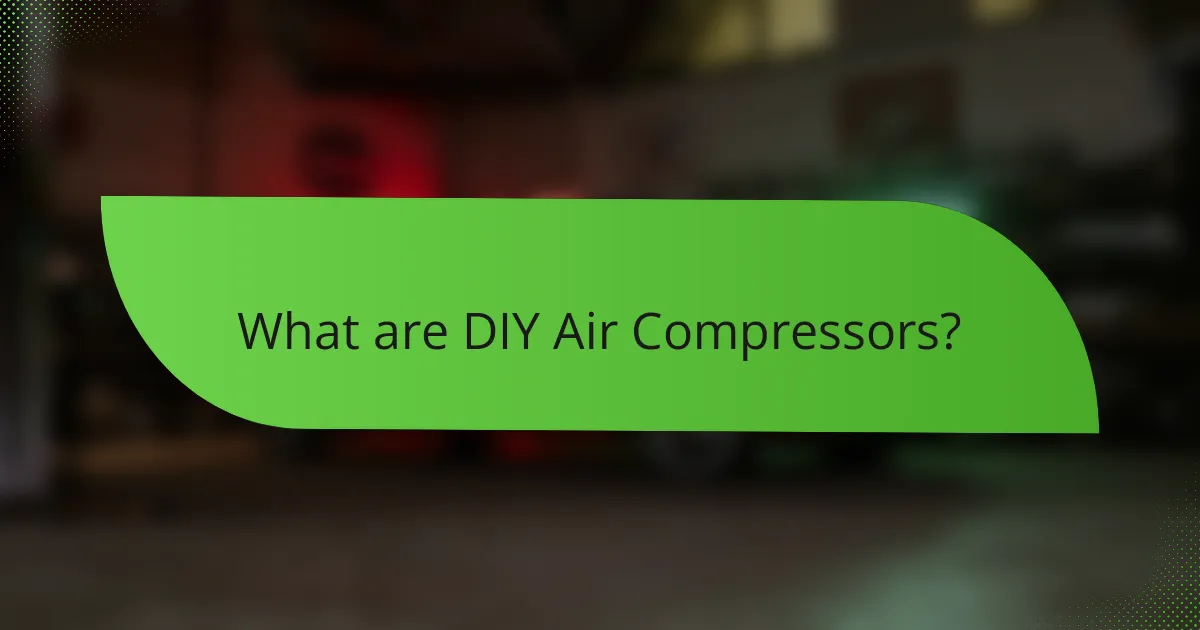
What are DIY Air Compressors?
DIY air compressors are devices that convert power into compressed air for various applications. They are typically assembled using readily available parts and materials. DIY air compressors can be powered by electric motors, gasoline engines, or even manual pumps. These compressors are often used for tasks like inflating tires, powering pneumatic tools, and spraying paint. The design and efficiency of a DIY air compressor depend on the motor power and the quality of components used. A well-built DIY air compressor can achieve significant air pressure output. For example, a compressor with a motor rated at 1.5 horsepower can generate pressures of up to 120 psi.
How do DIY Air Compressors function?
DIY air compressors function by converting mechanical energy into compressed air. This process typically involves a motor that drives a piston or diaphragm. The motor generates rotational power, which moves the piston within a cylinder. As the piston moves down, it creates a vacuum that draws in air. When the piston moves back up, it compresses the air in the cylinder. This compressed air is then stored in a tank for later use. The efficiency of this process is influenced by the motor’s power output. A higher power motor can produce greater air pressure and volume.
What are the key components of a DIY Air Compressor?
The key components of a DIY air compressor include a motor, a pump, a storage tank, and pressure regulation components. The motor provides the power necessary to drive the pump. The pump compresses air and forces it into the storage tank. The storage tank holds the compressed air for use. Pressure regulation components, such as gauges and valves, ensure safe operation and control the air pressure output. Each component plays a critical role in the functionality of the air compressor.
How does motor power influence the operation of a DIY Air Compressor?
Motor power directly affects the performance and efficiency of a DIY air compressor. Higher motor power allows the compressor to generate greater air pressure and volume. This results in faster filling times for air tanks. A motor rated at 1.5 HP can typically produce around 4-5 CFM (cubic feet per minute) at 90 PSI. Conversely, a lower power motor may struggle to maintain consistent pressure under load. Insufficient motor power can lead to overheating and reduced lifespan of the compressor. Therefore, selecting an appropriate motor power is crucial for optimal operation and longevity of the air compressor.
What are the advantages of using DIY Air Compressors?
DIY air compressors offer several advantages. They are cost-effective compared to commercial models. Building your own allows for customization to fit specific needs. DIY versions can be tailored for different applications, such as inflating tires or powering tools. They often use readily available materials, making them accessible for many. Additionally, assembling a DIY air compressor can enhance technical skills and knowledge. Users gain hands-on experience with tools and components. This process can lead to a deeper understanding of air compression technology. Overall, DIY air compressors provide flexibility, cost savings, and educational benefits.
How do DIY Air Compressors compare to commercial models?
DIY air compressors typically offer lower performance compared to commercial models. Commercial models are designed for high efficiency and durability. They often have more powerful motors, resulting in higher air pressure output. For example, commercial compressors can reach 150 PSI or more, while DIY versions usually max out around 100 PSI. Additionally, commercial models often include advanced features like better cooling systems and larger tanks. This allows for longer run times and less frequent cycling. DIY models may be more cost-effective but often lack the reliability needed for heavy-duty tasks. Overall, commercial air compressors are generally superior in performance and longevity.
What cost savings can be expected from DIY Air Compressors?
DIY air compressors can lead to significant cost savings. Building a DIY air compressor can save between 30% to 50% compared to purchasing a commercial unit. The savings arise from avoiding brand markups and labor costs associated with factory-made products. Additionally, DIY projects allow customization to specific needs, preventing overspending on unnecessary features. Maintenance costs are often lower with DIY models, as users can source parts independently. According to a study by HomeAdvisor, DIY projects can yield an average savings of $1,500 annually for homeowners. Overall, the initial investment in materials for a DIY air compressor can pay off quickly through these savings.
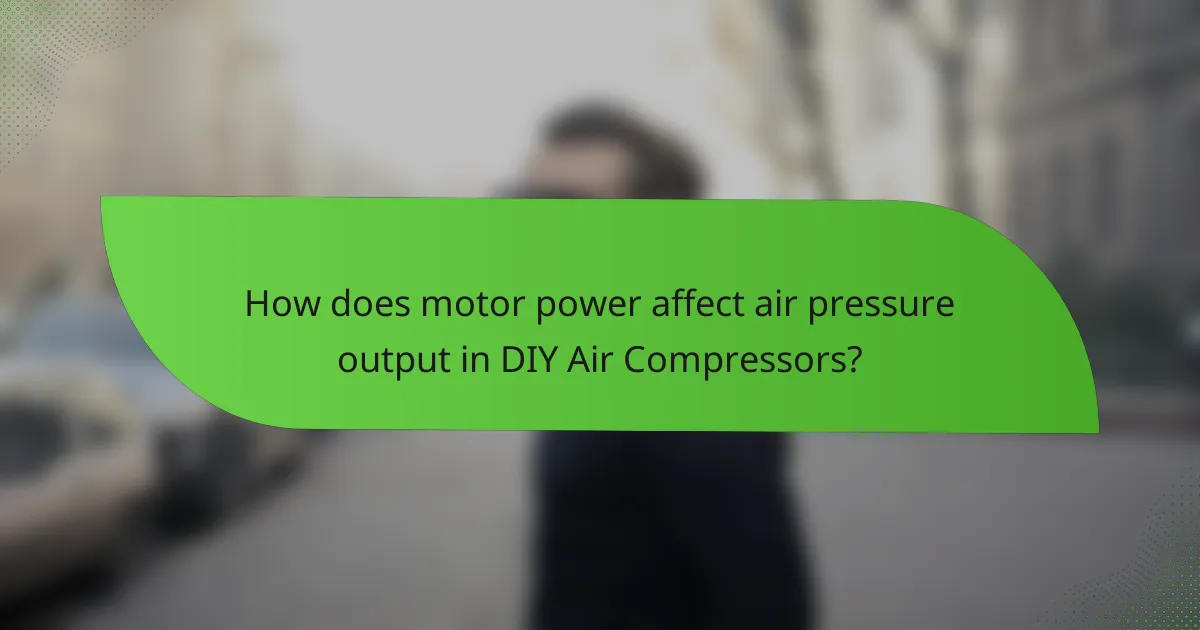
How does motor power affect air pressure output in DIY Air Compressors?
Motor power directly influences the air pressure output in DIY air compressors. Higher motor power typically results in increased air pressure. This is because more powerful motors can drive the compressor pump more efficiently. Increased efficiency allows for quicker compression of air. As a result, the compressor can achieve higher pressure levels in a shorter time. Conversely, lower motor power may lead to insufficient pressure output. For example, a 1 HP motor can generate around 90-120 PSI, while a 3 HP motor can achieve 150 PSI or more. Therefore, selecting an appropriately powered motor is crucial for desired air pressure performance.
What is the relationship between motor power and air pressure?
Motor power directly influences air pressure in an air compressor. Higher motor power allows for increased compression of air, resulting in higher air pressure output. This relationship is due to the motor’s ability to drive the compressor mechanism more forcefully. For example, a motor rated at 2 HP can generate significantly more pressure than a 1 HP motor. The efficiency of the compressor also plays a role; a well-designed compressor can maximize pressure output relative to motor power. Additionally, the relationship is evident in specifications; many compressors list maximum pressure ratings alongside motor power ratings.
How is air pressure measured in DIY Air Compressors?
Air pressure in DIY air compressors is measured using a pressure gauge. This gauge typically displays the pressure in pounds per square inch (PSI). The gauge is connected to the air tank of the compressor. As the compressor operates, it fills the tank with compressed air. The pressure gauge reflects the current air pressure inside the tank. Accurate measurements are crucial for safe operation and optimal performance. Most DIY compressors have gauges that can read up to 150 PSI or more. Regularly checking the gauge ensures the compressor operates within its designed pressure limits. This practice helps prevent damage to the compressor and enhances safety.
What motor power ratings are commonly used in DIY Air Compressors?
Common motor power ratings used in DIY air compressors typically range from 1 to 5 horsepower (HP). Most DIY air compressors utilize 1 to 3 HP motors for effective performance. A 1 HP motor generally provides sufficient power for light tasks. Motors rated at 2 HP are popular for moderate applications. Higher ratings, such as 3 to 5 HP, are often used for more demanding tasks. These power ratings correlate with the compressor’s ability to deliver air pressure effectively. For instance, a 2 HP motor can produce around 6 to 8 CFM (cubic feet per minute) at 90 PSI. This range makes it suitable for various DIY projects.
Why is motor power critical for performance?
Motor power is critical for performance because it directly influences the efficiency and capability of the air compressor. Higher motor power allows the compressor to generate greater air pressure and volume. This results in improved performance for various applications, such as powering tools or inflating tires. For instance, a compressor with a 2 HP motor can produce significantly more air pressure than a 1 HP model. According to industry standards, air compressors need adequate motor power to maintain consistent output under load. Insufficient motor power can lead to overheating and reduced lifespan of the equipment. Thus, selecting the right motor power is essential for optimal performance and reliability in air compressors.
How does insufficient motor power impact air pressure output?
Insufficient motor power reduces air pressure output in compressors. When a motor lacks adequate power, it struggles to generate the required rotational force. This leads to lower RPMs, which directly affects the compressor’s ability to compress air effectively. Consequently, the pressure output diminishes, resulting in inadequate performance for tools or tasks that require high pressure. For example, a compressor designed to output 120 PSI may only achieve 80 PSI if the motor is underpowered. This reduction can hinder the functionality of pneumatic tools, making them less efficient or unusable. Overall, motor power is critical for maintaining optimal air pressure output in compressors.
What are the optimal motor power levels for various applications?
The optimal motor power levels for various applications depend on the specific use case. For small DIY air compressors, a motor power of 1 to 2 horsepower (HP) is typically sufficient. This range works well for tasks like inflating tires or powering small pneumatic tools. For medium applications, such as spray painting or operating larger air tools, a motor power of 3 to 5 HP is recommended. This power level ensures adequate air pressure and volume for demanding tasks. Heavy-duty applications, including industrial air compressors, often require motors exceeding 5 HP. These motors provide the necessary power for continuous operation and high air demand. According to the American Society of Mechanical Engineers, selecting the right motor power is crucial for efficiency and performance in air compression systems.
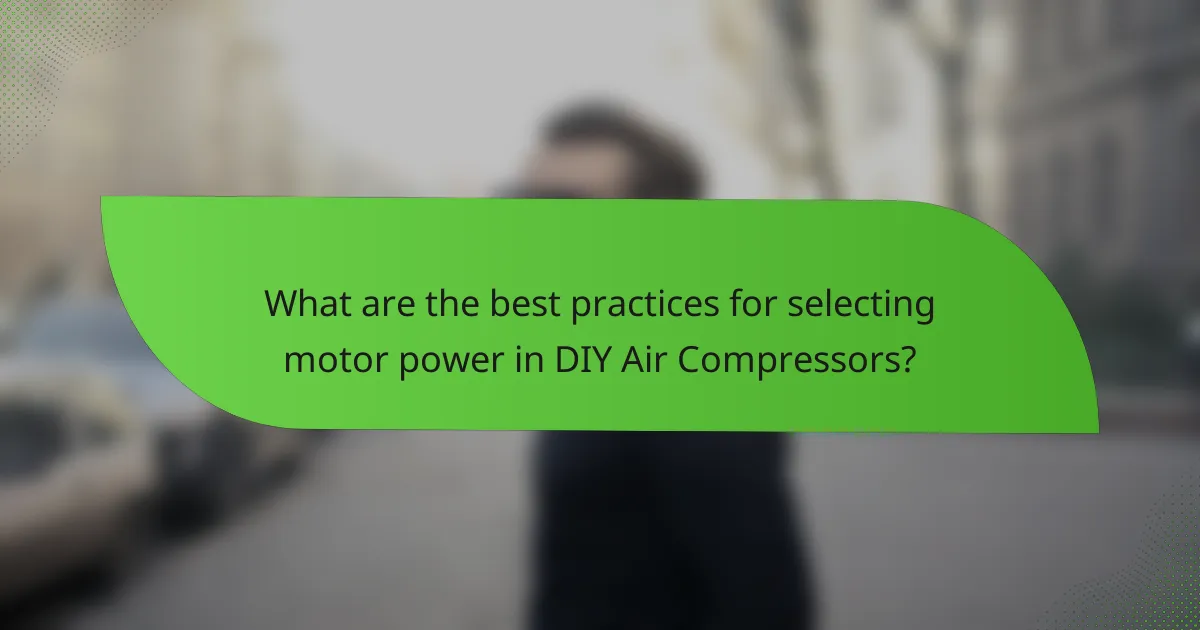
What are the best practices for selecting motor power in DIY Air Compressors?
Select a motor power that matches the intended use of the DIY air compressor. For light tasks, a motor with 1 to 2 horsepower is sufficient. For moderate tasks, consider 2 to 5 horsepower. Heavy-duty applications may require motors above 5 horsepower.
Evaluate the air pressure requirements in psi (pounds per square inch). Most DIY compressors operate effectively between 90 to 120 psi. Ensure the motor can provide the necessary airflow, measured in cubic feet per minute (CFM).
Check the duty cycle of the motor. A higher duty cycle means the motor can run longer without overheating. Choose a motor with a suitable voltage rating, typically 120V or 240V, depending on your power supply.
Finally, consider the efficiency of the motor. Brushless motors tend to be more efficient and have longer lifespans compared to brushed motors.
How can users determine the required motor power for their needs?
Users can determine the required motor power for their needs by calculating the air compressor’s CFM (cubic feet per minute) and PSI (pounds per square inch) requirements. The motor power must match or exceed these specifications to ensure optimal performance. For example, a compressor needing 5 CFM at 90 PSI typically requires a motor rated between 1.5 to 2 HP. Users should also consider the duty cycle, which indicates how long the compressor can run before needing a rest. A higher duty cycle may necessitate more power. Additionally, users can reference manufacturer guidelines, which often provide recommended motor sizes for specific applications. This ensures compatibility with tools and tasks.
What factors should be considered when choosing motor power?
When choosing motor power for DIY air compressors, consider the required air pressure and flow rate. The motor power must match the compressor’s intended use, such as inflating tires or powering pneumatic tools. Efficiency is also crucial; higher power motors can consume more energy. Additionally, consider the voltage and phase of the motor to ensure compatibility with your power supply. The duty cycle impacts how long the motor can run without overheating. Finally, the size and weight of the motor should align with the compressor’s design for portability and stability. Each of these factors influences the overall performance and effectiveness of the air compressor.
How can users optimize motor power for efficiency?
Users can optimize motor power for efficiency by selecting the right motor size for their air compressor. A motor that is too large can waste energy, while one that is too small may not provide adequate power. Properly matching the motor to the compressor’s requirements ensures optimal performance. Additionally, maintaining the motor through regular inspections and cleaning can prevent energy loss. Using high-efficiency motors can also contribute to better energy usage. According to the U.S. Department of Energy, upgrading to a premium efficiency motor can save up to 5-10% on energy costs. Lastly, implementing variable speed drives allows for better control of motor power, adapting to changing demands for increased efficiency.
What troubleshooting tips are available for motor power issues?
Check the power supply to the motor. Ensure that the outlet is functioning and providing the correct voltage. Inspect the power cord for any damage or loose connections. Verify that the motor’s circuit breaker or fuse is not tripped or blown. Listen for unusual sounds from the motor, which may indicate internal issues. Test the motor’s start capacitor, as a faulty capacitor can prevent the motor from starting. Measure the motor’s resistance with a multimeter to check for short circuits or open windings. Consult the motor’s manual for specific troubleshooting steps and specifications.
How can common motor power problems be resolved?
Common motor power problems can be resolved by checking the power supply and connections. Ensure the motor is receiving the correct voltage as specified by the manufacturer. Inspect wiring for any signs of damage or loose connections. Replace damaged wires to restore proper function. Verify the motor’s thermal overload protection is not tripped. If it is, allow the motor to cool down before resetting. Check for mechanical obstructions that may hinder motor operation. Remove any debris or blockages to ensure smooth movement. Regular maintenance, such as lubrication, can also prevent power issues. Following these steps can enhance motor performance and reliability.
What maintenance practices help sustain motor power performance?
Regular maintenance practices enhance motor power performance. Key practices include routine lubrication of moving parts. This reduces friction and wear, ensuring smooth operation. Cleaning air filters is also essential. Clogged filters impede airflow, affecting motor efficiency. Checking electrical connections prevents power loss. Loose connections can lead to performance drops. Additionally, inspecting and tightening belts maintains proper tension. This avoids slippage and power loss during operation. Lastly, monitoring operating temperatures helps prevent overheating. Excess heat can damage motor components and reduce performance. Implementing these practices can significantly prolong motor life and efficiency.
DIY air compressors are devices that convert power into compressed air for various applications, such as inflating tires and powering tools. The article explores the function, key components, and advantages of DIY air compressors, emphasizing the critical role of motor power in determining air pressure output. It details how motor power ratings influence performance, efficiency, and suitability for different tasks, while also comparing DIY models to commercial alternatives. Additionally, the article provides guidelines for selecting optimal motor power and maintenance practices to enhance performance and longevity.
